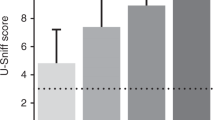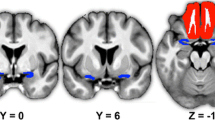Abstract
The olfactory bulb (OB) is considered to be the most important relay station in odor processing. The present study aimed to investigate the volumetric development of the human bulb and the olfactory function during childhood and youth. Furthermore, the present study aimed to investigate a possible correlation between OB volume and specific olfactory functions including odor threshold, odor discrimination and odor identification. A total of 87 subjects (46 boys, 41 girls), aged 1–17 years (mean age 8 years), participated in this study. None of them reported olfactory dysfunction or had signs of a dysfunctional sense of smell. Whenever possible, participants received a volumetric scan of the brain and lateralized olfactory tests. Volumetric measurements of the right and left OB were taken by manual segmentation of the coronal slices through the OB. Significant correlations between OB volumes and olfactory function were observed. Both, OB volumes and olfactory function increased with age, although the correlation between structure and function was not mediated by the subjects’ age. In conclusion, for the first time, the present study showed a correlation between OB volume and olfactory functions in children.



Similar content being viewed by others
References
Abolmaali ND, Hietschold V, Vogl TJ, Huttenbrink KB, Hummel T (2002) MR evaluation in patients with isolated anosmia since birth or early childhood. AJNR Am J Neuroradiol 23:157–164
Buschhüter D, Smitka M, Puschmann S, Gerber JC, Witt M, Abolmaali ND, Hummel T (2008) Correlation between olfactory bulb volume and olfactory function. Neuroimage 42:498–502
Cain WS, Gent JF, Goodspeed RB, Leonard G (1988) Evaluation of olfactory dysfunction in the connecticut chemosensory clinical research center (CCCRC). Laryngoscope 98:83–88
Cain WS, Stevens JC, Nickou CM, Giles A, Johnston I, Garcia-Medina MR (1995) Life-span development of odor identification, learning, and olfactory sensitivity. Perception 24:1457–1472
Conlin JR, Gathercole SE, Adams JW (2005) Children’s working memory: investigating performance limitations in complex span tasks. J Exp Child Psychol 90:303–317
Curtis MA, Kam M, Nannmark U, Anderson MF, Axell MZ, Wikkelso C, Holtas S, van Roon-Mom WM, Bjork-Eriksson T, Nordborg C, Frisen J, Dragunow M, Faull RL, Eriksson PS (2007) Human neuroblasts migrate to the olfactory bulb via a lateral ventricular extension. Science 315:1243–1249
Doty RL, Shaman P, Dann M (1984) Development of the university of Pennsylvania smell identification test: a standardized microencapsulated test of olfactory function. Physiol Behav 32:489–502
Ehrenstein WH, Ehrenstein A (1999) Psychophysical methods. In: Windhorst U, Johansson H (eds) Modern techniques in neuroscience research. Springer, Berlin, pp 1211–1241
Hudson R, Distel H (1999) The flavor of life: perinatal development of odor and taste preferences. Schweiz Med Wochenschr 129:176–181
Hummel T, Sekinger B, Wolf S, Pauli E, Kobal G (1997) “Sniffin’ sticks”: olfactory performance assessed by the combined testing of odor identification, odor discrimination and olfactory threshold. Chem Senses 22:39–52
Hummel T, Bensafi M, Nikolaus J, Knecht M, Laing DG, Schaal B (2007) Olfactory function in children assessed with psychophysical and electrophysiological techniques. Behav Brain Res 180:133–138
Kobal G, Klimek L, Wolfensberger M, Gudziol H, Temmel A, Owen CM, Seeber H, Pauli E, Hummel T (2000) Multicenter investigation of 1,036 subjects using a standardized method for the assessment of olfactory function combining tests of odor identification, odor discrimination, and olfactory thresholds. Eur Arch Otorhinolaryngol 257:205–211
Lledo PM, Gheusi G (2003) Olfactory processing in a changing brain. Neuroreport 14:1655–1663
Lledo PM, Saghatelyan A, Lemasson M (2004) Inhibitory interneurons in the olfactory bulb: from development to function. Neuroscientist 10:292–303
Marlier L, Schaal B, Soussignan R (1997) Orientation responses to biological odours in the human newborn. Initial pattern and postnatal plasticity. C R Acad Sci 3:999–1005
Mueller A, Abolmaali ND, Hakimi AR, Gloeckler T, Herting B, Reichmann H, Hummel T (2005a) Olfactory bulb volumes in patients with idiopathic Parkinson’s disease—a pilot study. J Neural Transm 112:1363–1370
Mueller A, Rodewald A, Reden J, Gerber J, von Kummer R, Hummel T (2005b) Reduced olfactory bulb volume in post-traumatic and post-infectious olfactory dysfunction. Neuroreport 16:475–478
Parent A, Carpenter MB (1996) Carpenter’s human neuroanatomy, vol 19. Williams and Wilkins, Baltimore
Richman RA, Post EM, Sheehe PR, Wright HN (1992) Olfactory performance during childhood.1. Development of an odorant identification test for children. J Pediatr 121:908–911
Richman RA, Post EM, Sheehe PR, Wright HN (2005) Olfactory performance during childhood—development of an odorant identification test for children. J Pediatr 121:908–911
Rombaux P, Mouraux A, Bertrand B, Nicolas G, Duprez T, Hummel T (2006) Olfactory function and olfactory bulb volume in patients with postinfectious olfactory loss. Laryngoscope 116:436–439
Rombaux P, Mouraux A, Bertrand B, Duprez T, Hummel T (2007) Can we smell without an olfactory bulb? Am J Rhinol 21:548–550
Rouby C, Gautier B, Chevalier G, Dubois D (1997) Cannaissance et reconnaissance d’une série olfactive chez l’enfant préscolaire. Enfance 1:152–171
Schneider JF, Floemer F (2009) Maturation of the olfactory bulbs: MR imaging findings. AJNR Am J Neuroradiol 30:1149–1152
Schwartze P (1991) Die Entwicklung des Riechsinnes—eine Übersicht. Pädiatrie Grenzgeb 30:339–344
Solbu EH (1990) Children’s sensitivity to odor of trimethylamine. J Chem Ecol 16:1829–1840
Thomann PA, Dos Santos V, Toro P, Schönknecht P, Essig M, Schröder J (2007) Reduced olfactory bulb and tract volume in early Alzheimer’s disease—a MRI study. Neurobiol Aging 30:838–841
Turetsky BI, Moberg PJ, Arnold SE, Doty RL, Gur RE (2003) Low olfactory bulb volume in first-degree relatives of patients with schizophrenia. Am J Psychiatr 160:703–708
WMA (1997) Recommendations guiding physicians in biomedical research involving human subjects. World Med Assoc Declar Helsinki—JAMA 277:925–926
Wolfensberger M, Schnieper I, Welge-Lussen A (2000) “Sniffin’ sticks”: a new olfactory test battery. Acta Otolaryngol 120:303–306
Yousem DM, Geckle RJ, Bilker W, McKeown DA, Doty RL (1996a) MR evaluation of patients with congenital hyposmia or anosmia. Am J Radiol 166:439–443
Yousem DM, Geckle RJ, Bilker WB, McKeown DA, Doty RL (1996b) Posttraumatic olfactory dysfunction: MR and clinical evaluation. AJNR Am J Neuroradiol 17:1171–1179
Yousem DM, Geckle RJ, Doty RL, Bilker WB (1997) Reproducibility and reliability of volumetric measurements of olfactory eloquent structures. Acad Radiol 4:264–269
Yousem DM, Geckle RJ, Bilker WB, Doty RL (1998) Olfactory bulb and tract and temporal lobe volumes. Normative data across decades. Ann NY Acad Sci 855:546–555
Yousem DM, Geckle RJ, Bilker WB, Kroger H, Doty RL (1999) Posttraumatic smell loss: relationship of psychophysical tests and volumes of the olfactory bulbs and tracts and the temporal lobes. Acad Radiol 6:264–272
Acknowledgments
This study was supported by the DDELTAS (Dijon-Dresden European Laboratories for Taste and Smell—LEA 549), underwritten by the Centre National de la Recherche Scientifique-Paris and the Technische Universität Dresden, and awarded to B. Schaal and T. Hummel, and a grant from the Roland Ernst Stiftung to T. Hummel.
Conflict of interest
None of the authors reports a potential conflict of interest.
Author information
Authors and Affiliations
Corresponding author
Rights and permissions
About this article
Cite this article
Hummel, T., Smitka, M., Puschmann, S. et al. Correlation between olfactory bulb volume and olfactory function in children and adolescents. Exp Brain Res 214, 285–291 (2011). https://doi.org/10.1007/s00221-011-2832-7
Received:
Accepted:
Published:
Issue Date:
DOI: https://doi.org/10.1007/s00221-011-2832-7




